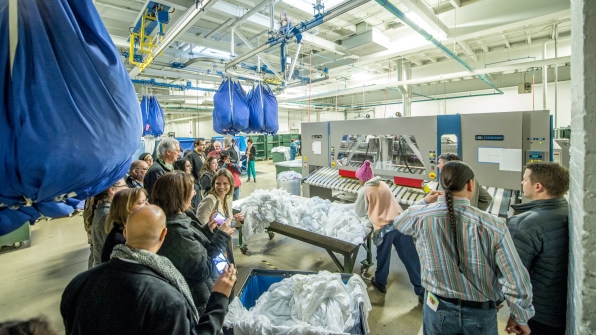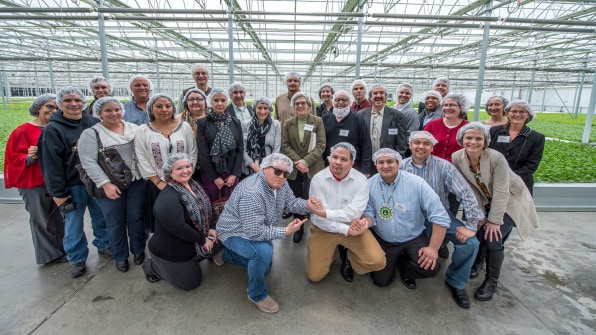In the U.S., the three wealthiest men own more wealth than all the wealth controlled by the 50% least wealthy Americans. Since 2009, 95% of income gains in the U.S. have gone to the top 1%. On top of that, the pressure for continuous production and consumption is depleting Earth’s natural resources at more than 1.5 times the planet’s ability to regenerate them and releasing harmful emissions that are warming the planet at a dangerous rate.
For people well-versed in the problems facing the U.S. today, these are familiar statistics, but to Ted Howard and Marjorie Kelly, the cofounder and executive vice president, respectively, of The Democracy Collaborative, they bear repeating—especially to prove that it doesn’t have to be this way.
In a new book called The Making of a Democratic Economy: How to Build Prosperity for the Many, Not the Few, Howard and Kelly spell out seven principles for creating a fairer and more sustainable economy that could help pull the U.S. out of the “extractive economy” that exists today.
Those values are community, inclusion, place, good work, sustainability, democratic ownership, and ethical finance.

[Photo: courtesy Democracy Collaborative]
The Democracy Collaborative is a national research institute dedicated to developing new strategies for a fairer economy, and in the book, Howard and Kelly cite specific examples of projects they’ve encountered that are fostering sustainability and creating local wealth. “We wanted to show how these projects really add up to a new paradigm,” Kelly says. “There’s so much work happening—there might be a worker cooperative in one place, or an impact investment in another—and it’s often hard to see how they all knit together. But it’s really about values.”

[Photo: courtesy Democracy Collaborative]
One example is an initiative launched in 2007 on the Pine Ridge Reservation in South Dakota, home to the Oglala Lakota, which centers around the principle of community, but it’s about much more. Pine Ridge has long encapsulated many issues that Native tribes currently face on their lands: lack of investment, little infrastructure, few jobs, and next to no economy. Government assistance, which is scant, is one of the few forms of financial support people on the reservation receive. This struggle stems from centuries of persecution at the hands of white settlers and decisions by the U.S. government to erode indigenous culture—up until 1978, for instance, many Native religious traditions were outlawed.
But now, members of younger generations are starting to reconnect with their culture’s traditions—and rebuilding community power. Nick Tilsen is among the more prominent of them. In 2007, he founded the nonprofit Thunder Valley Community Development Corporation to build prosperity on the Pine Ridge Reservation from the inside out. Tilsen spent hundreds of hours meeting with residents and cocreating a plan for the initiative. The design for Thunder Valley CDC includes a plan for the construction of affordable houses in a place where many families share trailers; youth are being trained in construction to carry out the plan and gain skills through an employee-owned company launched on the reservation. The project will also include amenities like playgrounds, farms, and community buildings. “At every step, the vision and building of the regenerative community arose from and within many circles of the community,” Kelly and Howard write.
Fostering well-being and stability for the Pine Ridge community is the primary goal of Thunder Valley CDC, but it’s also rooted in place—another principle of democratic economies. Previously, every dollar brought onto the Pine Ridge Reservation would leave again in 48 hours because there were no opportunities for people to spend money locally. By building out assets like homes and shops, Thunder Valley aims to create ways for wealth to remain in the community, instead of being pulled outward.
Another movement highlighted in the book is in Cleveland, Ohio, where a collection of organizations are pioneering another way to create wealth locally. There, Howard and Kelly write about how a group of “anchor institutions,” including hospitals and a university, teamed up and decided to source services like laundry and energy installation from a suite of local cooperatives that employ people from the distressed, majority-black communities around them. Now known as the “Cleveland model,” the mutual support of the anchor institutions and the Evergreen Cooperatives shows how prioritizing local community connections can create local wealth. Today, with the support of the anchor institution contracts, the Evergreen Cooperatives employ more than 220 people in well-paying jobs that have helped many who were previously living in poverty purchase homes—and perpetuate the cycle of local wealth building.
The program also touches on other principles: inclusion, good work, and democratic ownership. The Evergreen Cooperatives are collectively owned and employ mainly people of color, who have long been disadvantaged in the mainstream economy. They also equip people with job skills—like urban gardening and solar energy installation—that could support another crucial principle: sustainability. New democratic economies, the authors note, should try to minimize resource extraction and prioritize clean energy and sustainable industry as a vehicle for local wealth creation.
For the democratic economy to work, it needs financial institutions that will make fair loans and seed capital to projects that, while they might not generate huge monetary returns, will support local and collective well-being. This ethical finance is happening in the UK, where there’s an effort underway to establish local cooperatively owned banks, and in parts of the U.S., where activists in cities like New York and San Francisco are pushing for public banks to finance local projects like affordable housing and sustainable transportation.
The projects in The Making of a Democratic Economy, Kelly and Howard note, all have the potential to scale and spark replicas across the country or even the world. In collecting them all in this book, the authors hope to convey that as individually or circumstantially motivated as they may be, they all represent a shift away from a mainstream economy that’s no longer working for the majority of people, and the potential to design thoughtful alternatives.
(14)